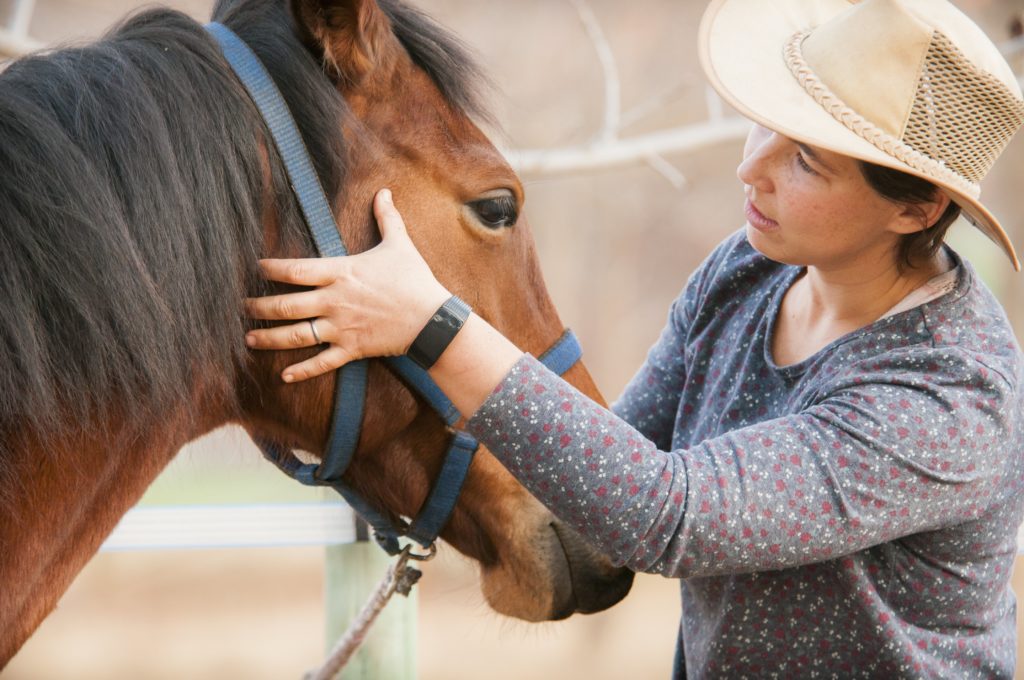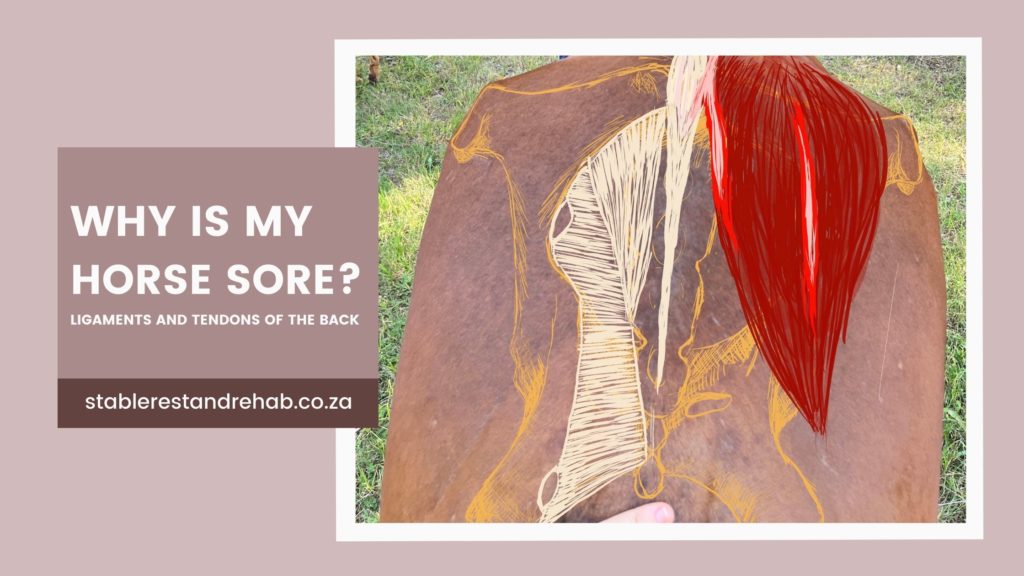In horses, pathologies and injuries affecting the ligaments and tendons in the back and pelvis are some of the most challenging to diagnose and treat, however, they are also one of the most treatable conditions. With a vast amount of muscle mass available in these areas, tendon and ligament weaknesses can be managed through adequate strengthening and retraining of these muscle groups.
Horses often injure the pelvic ligaments leading to acute or chronic Sacro-iliac joint pain, pelvic rotation and abnormal spinal curvature. This in turn negatively affects the horse’s posture, movement and performance. Despite the complexity of equine pelvic injuries, they respond well to treatment.
If you have a horse that suffers from a rotated pelvis, chronic Sacro-iliac pain, or weak muscle tone over the back and hindquarter, then this article is perfect for you!
Understanding the Anatomy Of A Horse’s Back And Pelvis
The horse’s spine is designed to support optimal function. The inherently unstable spine is stabilized by a system of muscles, tendons and ligaments, working in concert with the bony structures of the spine.
The Equine Thoracic Spine
In the thoracic region (i.e., the area where your saddle sits) the vertebrae are primarily stabilized by the ribs. The ribs limit the amount of sideways or lateral movement available in the region.
The thoracic spinous processes (i.e., upward-pointing bony projections) on the top of the spine limit the amount of extension in the area by creating a physical block. In conditions such as kissing spine, the spinous processes are too close together and the bony block becomes extremely painful and debilitating for the horse.
The Equine Lumbar Spine
As we move into the lumbar region, the vertebrae take on a very different shape. Lumbar vertebrae have sturdier spinous processes and long wings on the side of each vertebra. These again limit the amount of movement available but provide strong points of muscle attachment on the underside of the vertebrae.
The Horse’s Spinal Stabilizers
Working alone, passive spinal stabilizers (ie., the shape of the bones) cannot prevent extension of the thoracic and lumbar spinal regions; an active component is needed to maintain the spine in a neutral position to resist gravity – consider the weight of the organs that are ‘suspended’ beneath the spine – or to achieve active spinal flexion.
This is where the “true” spinal stabilizers come into play. Muscles such as the multifidus stabilize the spine at the level closest to the spine, while the muscles and muscle chains beneath the spine provide more active resistance against involuntary extension.
Not only do these muscle structures resist unwanted extension, they also facilitate active spinal flexion. It is easy to see why these muscles are essential to maintaining a healthy spine and pelvis.
The abdominal muscles create a basket or net holding up the organs and providing stabilization to the spine during movement. The abdominal muscles run between the pelvis, chest and ribs.
The Interconnectedeness Between the Horse’s Spine And Pelvis
The hindlimb is attached to the spine through the pelvis – a major attachment point for huge muscle groups in the limb, back and beneath the spine.
The pelvis connects to the sacrum through the sacroiliac joint (SIJ), a large flat joint with very little movement and very strong ligaments holding it all together. The joint is not only held together with the ligaments that are directly between the two bones but by ligaments all around the pelvis, from the tuber ischi to the tuber sacrale, both inside and above the pelvis.
These stabilizing ligaments include the ventral sacroiliac ligament, dorsal sacroiliac ligament, sacrosciatic or broad sacrotuberous ligament, supraspinous ligament, accessory femoral ligament, and the tendon of the longissimus muscle.
It is the combination of these structures (and many others) that provide the spine and pelvis with the passive and dynamic stability it needs to be able to function optimally, and with good mobility.
If any of these structures become injured or compromised, we will see a ripple effect in the other structures as they adapt and change their function to compensate for a loss of or change in function of the damaged structure. This ripple effect impacts the entire horse.
Knowing When Your Horse is in Pain
Horses can’t use words to tell us when they are in pain, but changes in performance, behaviour or gait are the horse’s efforts to communicate their pain to their owner. The signs and symptoms of pelvic pain include:
- Subtle or shifting lameness.
- Changes in their movement or performance, e.g., an inability to do an exercise they had previously mastered.
- Changes in behaviour either when handling them in-hand or under saddle, e.g., bolting, biting, unwillingness to be caught etc.
- Changes in their muscle mass or development around the back or the hindquarters, and more.
If you are ever concerned that your horse might be in pain, especially when the cause of the pain is not obvious, a full Veterinary Physiotherapy assessment can provide a good starting point for Veterinary diagnostic evaluation.
Speak to your trainer, veterinarian or veterinary physiotherapist if you are in doubt, but above all trust your horse to tell you when something is not as it should be.
Happy horses are willing and eager partners. If we find ourselves with a ‘naughty’, ‘resistant’, ‘dominant’ horse who ‘needs to be put in his place’ and ‘shown who is boss’, we very likely have a horse who is experiencing pain and is being misunderstood.
Recent research on this subject highlights that horses who display certain behaviours are highly likely to be experiencing pain or to have a lameness. Our perception of these “bad” behaviours needs to drastically change; instead of punishing the horse, we need to ask “why” the horse is showing these behaviours.
Pain Control
Once we have determined that horses are experiencing pain, and where that pain is coming from, our first step in rehabilitating the injury is to break the cycle of pain that the horse is experiencing.
We all know that sometimes healing is an uncomfortable process; unfortunately, we cannot explain to horses that the temporary discomfort is for their own good. Breaking the pain cycle is an essential component of successful rehabilitation; it helps horses “buy into” the treatment plan instead of becoming frightened and resistant.
Pain control is performed in several different ways, and the best results are often achieved through a combined approach:
- Pharmacological pain control,
- Rest or a change in the activity of the horse,
- Electrotherapy modalities such as PEMF, laser, and TENS
- Manual therapy such as massage and mobilization,
- Additional modalities such as kinesiotape.
Electrotherapy, manual therapy and kinesiotape all have a pain control component, as well as stimulating and facilitating healthy healing of the tissues involved. Additionally, manual therapies, kinesiotape and targeted exercises can help us restore mobility, neurological feedback, and optimal functioning of the involved structures.
The Importance of Exercise
Movement is life! Through targeted therapeutic movements we can treat pain and dysfunction, we can restore mobility, increase stability, flexibility, and so much more.
We can heal the body when we guide the horse through “new” healthy movement patterns – a process made easier and more effective when we combine movement with the tools we mentioned above.
While the tools and modalities mentioned above are excellent, on their own they can only bring temporary relief to an injured horse. The key to successful rehabilitation and lasting results is teaching the horse to use their body in a different, healthier way.
To rehabilitate the body through movement, we need to design an individualized program that incorporates both static and dynamic exercises. Let’s briefly discuss these two different approaches to movement.
Daily ‘Yoga’ Routines
During the initial phases of healing when rest is important, a daily routine of static exercises can be incorporated into the management of the horse. These exercises allow us to hit the reset button on the muscle activation patterns; retraining the muscles to achieve correct stabilization and mobilization of the horse’s spine.
Without stability, there can be no mobility!
This daily routine focuses on:
- Re-activating and strengthening muscles such as the multifidus
- Restoring spinal mobility
- Activating the stabilizers of the limbs
- Targeting the areas where an individual horse may be weakest
These exercises can be performed by an owner, but we must also realise that our horses are very good at evading correct movement and opting for the ‘easy’ way out. If we fail to recognize these evasions, the exercises will no longer be effective.
Additionally, because we are aiming to restore lost movement and reduce pain, many horses may find aspects of these exercises uncomfortable or unpleasant. Working with a trainer and physiotherapist can allow us to not only be effective but also to positively reinforce the exercises and allow them to be a pleasurable and even fun experience for the horse.
Weekly Exercise Regimen
Additionally, the weekly exercise routine for a horse rehabilitating from a tendon or ligament related injury in the back or spine should include targeted active exercise progressing from a walk, to trot and canter, focusing on:
- Activating and building the topline
- Engaging the abdominal muscles, and the spinal stabilizers
Many training aids and strategies can be used to facilitate this process, such as a theraband, cavalleti rails, hill work, work on different surfaces, etc.
The important consideration is that in all exercises, a positive posture is trained, rewarded and maintained, enabling the correct use of the musculoskeletal system.
Regardless of the horse’s current or future ridden discipline, the foundational posture and biomechanics remain the same during the initial phases. Only once the horse has mastered the basics of a correct posture can they move onto a sport-specific training program.
Sport-specific training programs are designed to protect and develop the horse for optimal performance in a specific ridden discipline. These programs strengthen the horse to carry the load the horse will endure once the spine is adequately stabilized through passive and active structures.
It Takes a Team
Nothing could be more important, than realizing that it takes a team to be effective in a rehabilitation program.
Combining the observations of the owner, with the knowledge and diagnostic capabilities of a Veterinarian, the palpation and rehabilitation techniques of a Veterinary Physiotherapist, and the skill and commitment of a Trainer is the best way to support the horse through the journey from injury or chronic pain to full recovery.
Conclusion
The horse’s spine and pelvis are complex structures stabilized by ligaments, tendons and muscles, all of which are at risk of injury from trauma, overloading or incorrect work.
If you suspect that your horse may be suffering from pain in its back, spine or pelvis, seek the advice of your Veterinarian or Veterinary Physiotherapist.
These medical professionals will ensure that a tailored treatment and rehabilitation program is created to allow your horse to optimally heal and recover so that they can live a pain-free life as a willing partner to you.

About the Author:
Ané Lloyd registered Veterinary Physiotherapist, owner and manager of Stable Rest and Rehab is dedicated to the individual care and rehabilitation of each horse boarding at our exclusive facility.
Have you helped your horse recover from a tendon injury?
You can help future horses and owners to navigate this challenging journey by filling in our quick survey:

